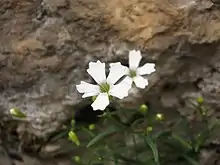Heliosperma
Heliosperma is a genus of flowering plants in the family Caryophyllaceae.[2] As such, it is closely related to the large genus Silene, but its members can be told apart from Silene by the crest of long papillae on the seeds.[1] The majority of the species are narrow endemics from the Balkan Peninsula, but H. alpestre is endemic to the Eastern Alps, and H. pusillum is found from the Cordillera Cantábrica in northern Spain to the Carpathians.[3] Like members of the genus Silene and other related genera, Heliosperma is attacked by species of the anther smut fungus Microbotryum.[4] Cases of parallel divergence events between alpine and mountain populations have been reported in this genus.[5][6]
| Heliosperma | |
|---|---|
 | |
| Heliosperma pusillum | |
| Scientific classification | |
| Kingdom: | Plantae |
| Clade: | Tracheophytes |
| Clade: | Angiosperms |
| Clade: | Eudicots |
| Order: | Caryophyllales |
| Family: | Caryophyllaceae |
| Genus: | Heliosperma (Rchb.) Rchb. |
| Synonyms [1] | |
| |
Species
Around 15 species are currently recognised in the genus:[7]
- Heliosperma albanicum K.Malý
- Heliosperma alpestre Rchb. – Eastern Alps
- Heliosperma chromodontum Rohrb. – Greece
- Heliosperma insulare Trinajstić – Croatia
- Heliosperma intonsum (Greuter & Melzh.) Niketić & Stevan. – Greece
- Heliosperma macranthum Pančić
- Heliosperma monachorum Vis. & Pančić
- Heliosperma nikolicii (A.Seliger & Wraber) Niketić & Stevan. – Kosovo
- Heliosperma oliverae Niketić & Stevan. – Montenegro
- Heliosperma pudibundum Griseb.
- Heliosperma pusillum Vis. – NW Spain, Pyrenees, Alps, Carpathians
- Heliosperma retzdorffianum Maly – Bosnia and Herzegovina
- Heliosperma tommasinii Vis. – Montenegro, Albania
- Heliosperma vandasii Neumayer – Macedonia
- Heliosperma veselskyi Janka – Slovenia
References
- Božo Frajman; Richard K. Rabeler (2006). "Proposal to conserve the name Heliosperma against Ixoca (Caryophyllaceae, Sileneae)" (PDF). Taxon. 55 (3): 801–808. doi:10.2307/25065663. hdl:2027.42/146904. JSTOR 25065663.
- Božo Frajman; Frida Eggens; Bengt Oxelman (2009). "Hybrid origins and homoploid reticulate evolution within Heliosperma (Sileneae, Caryophyllaceae) – a multigene phylogenetic approach with relative dating". Systematic Biology. 58 (3): 328–345. doi:10.1093/sysbio/syp030. PMID 20525587.
- Božo Frajman (2007). Taxonomy and reticulate phylogeny of Heliosperma and related genera (Sileneae, Caryophyllaceae) (PDF) (Ph.D. thesis). Uppsala University. ISBN 978-91-554-6946-7.
- Marcin Piątek; Matthias Lutz; Anna Ronikier; Martin Kemler; Urszula Świderska-Burek (2012). "Microbotryum heliospermae, a new anther smut fungus parasitic on Heliosperma pusillum in the mountains of the European Alpine System". Fungal Biology. 116 (2): 185–195. doi:10.1016/j.funbio.2011.10.011. PMID 22289764.
- Trucchi, Emiliano; Frajman, Božo; Haverkamp, Thomas H. A.; Schönswetter, Peter; Paun, Ovidiu (2017). "Genomic analyses suggest parallel ecological divergence in Heliosperma pusillum (Caryophyllaceae)". New Phytologist. 216 (1): 267–278. doi:10.1111/nph.14722. ISSN 1469-8137. PMC 5601199. PMID 28782803.
- Szukala, Aglaia; Lovegrove-Walsh, Jessica; Luqman, Hirzi; Fior, Simone; Wolfe, Thomas Mahteson; Frajman, Bozo; Schoenswetter, Peter; Paun, Ovidiu (2022). "Polygenic routes lead to parallel altitudinal adaptation in Heliosperma pusillum (Caryophyllaceae)". Molecular Ecology. mec.16393. doi:10.1111/mec.16393.
- Božo Frajman; Bengt Oxelman (2007). "Reticulate phylogenetics and phytogeographical structure of Heliosperma (Sileneae, Caryophyllaceae) inferred from chloroplast and nuclear DNA sequences" (PDF). Molecular Phylogenetics and Evolution. 43 (1): 140–155. doi:10.1016/j.ympev.2006.11.003. PMID 17188521.
Further reading
- Marjan Niketić; Vladimir Stevanović (2007). "A new species of Heliosperma (Caryophyllaceae) from Serbia and Montenegro". Botanical Journal of the Linnean Society. 154 (1): 55–63. doi:10.1111/j.1095-8339.2007.00643.x.
External links
 Data related to Heliosperma at Wikispecies
Data related to Heliosperma at Wikispecies Media related to Heliosperma at Wikimedia Commons
Media related to Heliosperma at Wikimedia Commons